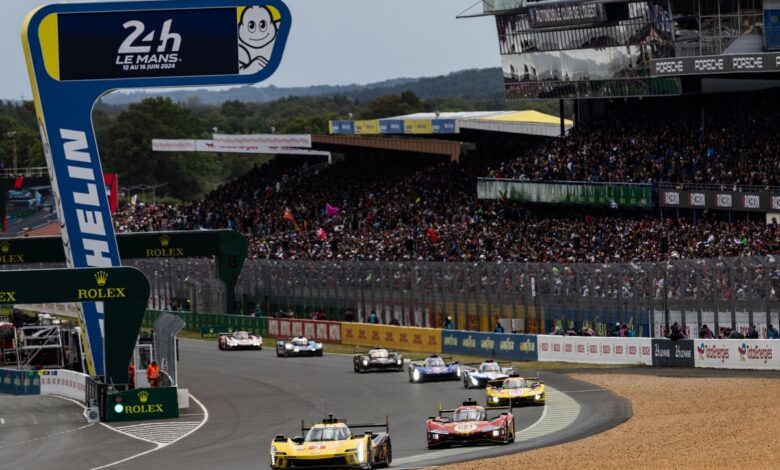The Le Mans Hypercar strength Cadillac’s LMDh couldn’t fight against

2024 marked the second year of the merged Le Mans Hypercar and LMDh regulations into the WEC’s Hypercar category, ruled by a Balance of Performance, but LMDh cars are yet to grab their first win at the Le Mans 24 Hours after an extremely competitive race this year.
Together with veteran Richard Westbrook, Earl Bamber and Alex Lynn had achieved a third-place finish in their Cadillac V-Series.R in the 2023 contest, led by the #51 Ferrari and the #8 Toyota. But this time around, only LMH machinery made it to the podium at Circuit de la Sarthe – the #50 Ferrari took the win from the #7 Toyota and the #51 Ferrari.
The polesitting #6 Porsche LMDh was just one second off the podium, with Andre Lotterer’s fears that team-mate Kevin Estre’s “exceptional” pole lap “maybe is not 100% representative of the performance” somewhat justified.
Meanwhile, the #2 Cadillac LMDh now shared by Bamber and Lynn with Alex Palou was in contention for a win for a long time, leading after 21 hours. However, it suffered from higher-than-average tyre degradation in mixed track conditions and ended up seventh under the chequered flag.
“At one point, it was looking very good, but in the end, I think Ferrari and Toyota just had a little bit more pace in all conditions,” Alex Lynn told Motorsport.com.
“That was ultimately the difference. At certain points we could match them, but never have something extra. Also, they were always very, very competitive. I think we were looking okay for a P3, but in the end we had a bad last hour or so, and that was it.”
“The Hypercars are very strong with the four-wheel drive, that’s why they’re all on the podium”, Earl Bamber added when speaking to Motorsport.com. “It’s hard to fight against.”

#7 Toyota Gazoo Racing Toyota GR010 – Hybrid: Jose Maria Lopez, Kamui Kobayashi, Nyck De Vries
Photo by: Alexander Trienitz
Toyota, Ferrari and Peugeot’s four-wheel-drive set-up comes in particularly handy in wet conditions, due to the extra traction this provides compared to the rear-wheel-drive LMDhs. In this particular instance, although a number of showers spiced up the race, this was partly mitigated by the safety car neutralising the race when the rain was at its worst, between 3:45am and 8:10am.
LMH cars were faster in all sectors in the race, with two Toyotas and two Ferraris leading the way on the Mulsanne straight and its two chicanes – the leading LMDh was the #2 Cadillac driven by Palou [1m20.048s], nearly three tenths off Sebastien Buemi’s #8 Toyota [1m19.786].
In the third sector, comprised of many corners with various speed profiles, Alessandro Pier Guidi was fastest in the #51 Ferrari with a 1m35.364s time, but Porsche’s Laurens Vanthoor and Cadillac’s Palou were just 0.085s and 0.089s off respectively.
Of course, the fastest race times were set in dry conditions, and with no session being run fully in wet conditions, analysing fully the advantage enjoyed by LMH cars is tricky.
Porsche’s Frederic Makowiecki admitted to Motorsport.com after the race that the German constructor was “lacking a little bit to be able to compete with Toyota and Ferrari. Not much, but a little too much.
“The difference is [Ferrari] can overtake you, but you can’t overtake them! This is getting complicated: we’re not quite on an equal footing.”
The aforementioned sector 2 times on the Mulsanne straight tend to corroborate the French veteran’s analysis. On the other hand, three cars recorded a 344.5km/h top speed in the race – both Toyotas and… Felipe Nasr’s #4 Porsche. But it was the only instance when one of the German cars went above 339.1km/h over the 24 hours, with the Brazilian driver most likely catching a big tow.
Looking at each car’s average top five speed-trap entries, the picture becomes clearer with both Toyotas on 342.6km/h and 342.1km/h and two Ferraris on 340.9km/h and 340.6km/h. The top LMDh becomes the #36 Alpine on 339.1km/h, with the quickest Porsche reaching 338.9km/h thanks to Jota’s #12 customer entry and no Cadillac doing any better than 336km/h for the #2 car.
In the end, there is little regret in the American camp. “Ultimately, I think this race we maximised,” Lynn added. “I was really proud of how we did. We had, I think, a really strong race. It was just Ferrari and Toyota in particular.
“Obviously I know we got beaten by two Porsches, but I don’t feel like they were better. We lost to them, but Ferrari and Toyota were better.”

Le MansFerrari’s WEC title hopes “back on track” after Le Mans win

Le MansHow Ferrari overcame multiple threats to defend its Le Mans crown

Le MansThe “unorthodox” approach taken by Manthey in Le Mans LMGT3-winning strategy

Le MansBMW won’t accept Ferrari’s “very unfair” penalty for Vanthoor/Kubica crash


